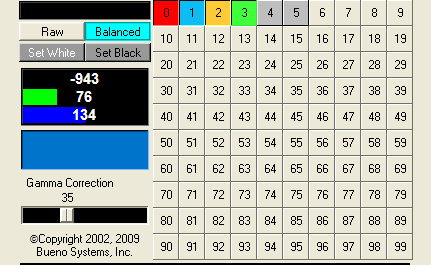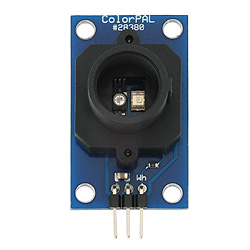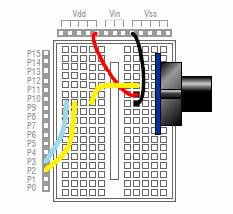Acrob040: Rozdiel medzi revíziami
Zo stránky SensorWiki
Bez shrnutí editace |
|||
| Riadok 259: | Riadok 259: | ||
Following Arduino code works with an original Parallax (or PhiPi) ColorDemo.exe program available at | Following Arduino code works with an original Parallax (or PhiPi) ColorDemo.exe program available at | ||
the following address: http://www.parallax.com/Portals/0/Downloads/docs/prod/sens/ColorPAL_programs.zip | the following address: http://www.parallax.com/Portals/0/Downloads/docs/prod/sens/ColorPAL_programs.zip | ||
[[Obrázok:ColorPAL_demo.png|center]] | |||
<source lang="c"> | <source lang="c"> | ||
Verzia z 15:09, 29. február 2012
Color sensor
Following text will show You a basic connection and operation of the Parallax ColorPal digital colour sensor module.
Product page: #28380 ColorPAL
- Documentation (.pdf)
- Chip datasheet (.pdf)
Schematic diagram:
Demo program:
/*====================================================
/ Connect ColorPAL SIG signal to Arduino pin 2 and 3
/ Add 2K pullup resistor from pins 2 & 3 to +5v
/ See the result on the serial terminal,
/ Baud Rate = 115200 kbps
/ Works with Arduino 0.20, not with 1.00 and above?
/ Source: http://be470merchantuy.blogspot.com/2012/02/lab-3-serialread-and-colorpal.html
/====================================================*/
#include <SoftwareSerial.h>
SoftwareSerial ColorPAL(2, 3); // rx = 2, tx = 3
int red, grn, blu;
int gotcolor = 0;
int letter;
int redBlackRef=8;
int redWhiteRef=234;
int grnBlackRef=3;
int grnWhiteRef=166;
int bluBlackRef=6;
int bluWhiteRef=285;
void setup(){
Serial.begin(115200); // Start communication with serial port read value
ColorPAL.begin(4800); // Send signal to led to read value
pinMode(2,INPUT); // serial pin out from color pal
pinMode(3,INPUT); // from same serial pin, signal pulls up, sends, pulls down, reads
digitalWrite(2,HIGH); // Enable the pull-up resistor
digitalWrite(3,HIGH); // Enable the pull-up resistor
pinMode(2,OUTPUT); // send signal out
pinMode(3,OUTPUT);
digitalWrite(2,LOW); // turn pin off so pin 3 can go high
digitalWrite(3,LOW);
pinMode(2,INPUT); // Input signal to print
pinMode(3,INPUT);
Serial.println("Pass 1");
delay(20);
while( digitalRead(2) != HIGH || digitalRead(3) != HIGH ) {
Serial.println("In the loop");
delay(50);
}
Serial.println("Pass 2");
pinMode(2,OUTPUT);
pinMode(3,OUTPUT);
digitalWrite(2,LOW);
digitalWrite(3,LOW);
delay(100); // spec is 80, but not all ColorPAL units work with 80
pinMode(2,INPUT);
pinMode(3,OUTPUT);
delay(100);
}
// This oscillates back and forth on one wire to turn off led, send signal,
// turn on led, read signal. very fast strobe read - arduino is not capable of
// one wire signal communication over digital ports, so this is a way around
// that over 2 wires communicating with 1 pin on the sensor.
//---------------------------------
void loop()
{
readColor();
int redCorrect = (255*(red-redBlackRef))/(redWhiteRef-redBlackRef);
int bluCorrect = (255*(blu-bluBlackRef))/(bluWhiteRef-bluBlackRef);
int grnCorrect = (255*(grn-grnBlackRef))/(grnWhiteRef-grnBlackRef);
Serial.print("R");
Serial.print(redCorrect);
Serial.print(" ");
Serial.print(red);
Serial.print(" G");
Serial.print(grnCorrect);
Serial.print(" ");
Serial.print(grn);
Serial.print(" B");
Serial.print(bluCorrect);
Serial.print(" ");
Serial.println(blu);
//int redCorrect = red;
//int bluCorrect = grn;
//int grnCorrect = blu;
if (redCorrect > 240 && redCorrect <=255 && grnCorrect >240 && grnCorrect <=255 && bluCorrect >240 && bluCorrect <= 255)
{
Serial.print("White");
delay(100);
}
if (redCorrect > 0 && redCorrect <= 40 && grnCorrect >0 && grnCorrect <=40 && bluCorrect >0 && bluCorrect <= 40){
Serial.print("Black");
delay(100);
}
if (redCorrect > 140 && redCorrect <= 255 && grnCorrect >0 && grnCorrect <=80 && bluCorrect >0 && bluCorrect <= 130){
Serial.print("Red");
delay(100);
}
if (redCorrect > 200 && redCorrect <= 255 && grnCorrect >0 && grnCorrect <=200 && bluCorrect >130 && bluCorrect <= 255){
Serial.print("Pink");
delay(100);
}
if (redCorrect > 200 && redCorrect <= 255 && grnCorrect >80 && grnCorrect <=160 && bluCorrect >0 && bluCorrect <= 120){
Serial.print("Orange");
delay(100);
}
if (redCorrect > 180 && redCorrect <= 255 && grnCorrect >200 && grnCorrect <=255 && bluCorrect >0 && bluCorrect <= 255){
Serial.print("Yellow");
delay(100);
}
if (redCorrect > 120 && redCorrect <= 200 && grnCorrect >0 && grnCorrect <=230 && bluCorrect >120 && bluCorrect <= 255){
Serial.print("Purple");
delay(100);
}
if (redCorrect > 0 && redCorrect <= 180 && grnCorrect >100 && grnCorrect <=255 && bluCorrect >0 && bluCorrect <= 170){
Serial.print("Green");
delay(100);
}
if (redCorrect > 0 && redCorrect <= 180 && grnCorrect >0 && grnCorrect <=255 && bluCorrect >170 && bluCorrect <= 255){
Serial.print("Blue");
delay(100);
}
gotcolor = 0;
delay(100);
} /* End of loop() */
/* ***************************************** */
/* Function readColor() */
/* Reads ColorPAL, putting results in the */
/* red, grn, blu variables */
/* ***************************************** */
void readColor()
{
char rByte[9];
char dummy[4];
delay(20);
ColorPAL.begin(4800);
ColorPAL.print("= (00 $ m) !"); // set up loop to continuously send color data
pinMode(3,INPUT);
gotcolor = 0;
while (gotcolor == 0)
{
rByte[0] = ColorPAL.read();
if( rByte[0] == '$' )
{
gotcolor = 1;
for (int i=0; i<9; i++)
{
rByte[i] = ColorPAL.read();
// Serial.print(rByte[i]);
}
Serial.println("");
dummy[0] = rByte[0];
dummy[1] = rByte[1];
dummy[2] = rByte[2];
dummy[3] = 0;
red = strtol(dummy,NULL,16);
dummy[0] = rByte[3];
dummy[1] = rByte[4];
dummy[2] = rByte[5];
grn = strtol(dummy,NULL,16);
dummy[0] = rByte[6];
dummy[1] = rByte[7];
dummy[2] = rByte[8];
blu = strtol(dummy,NULL,16);
}
}
} /* End of function readColor() */
If the program works correctly, it will send to the serial port (115 200 Bd) following data:
R27 32 G106 71 B40 50 Green R37 41 G134 89 B50 61 Green R34 39 G126 84 B46 57 Green
R19 25 G84 57 B27 36 R18 24 G78 53 B26 35 R15 22 G65 45 B23 32 R15 22 G68 47 B22 31 R14 21 G68 47 B21 30
R16 23 G31 23 B26 35 Black R16 23 G32 24 B30 39 Black R15 22 G26 20 B21 30 Black R10 17 G21 17 B19 27
Demo software
Following Arduino code works with an original Parallax (or PhiPi) ColorDemo.exe program available at the following address: http://www.parallax.com/Portals/0/Downloads/docs/prod/sens/ColorPAL_programs.zip

/*====================================================
/ Connect ColorPAL SIG signal to Arduino pin 2 and 3
/ Baud Rate = 9600 kbps
/ Works with Arduino 0.20, not with 1.00 and above?
/====================================================*/
#include <SoftwareSerial.h>
SoftwareSerial ColorPAL(2, 3); // rx = 2, tx = 3
int red, grn, blu;
int gotcolor = 0;
int letter;
char colorByte[9];
void setup(){
// for colordemo 9600,
Serial.begin(9600); // Start communication with serial port read value
ColorPAL.begin(4800); // Send signal to led to read value
pinMode(2,INPUT); // serial pin out from color pal
pinMode(3,INPUT); // from same serial pin, signal pulls up, sends, pulls down, reads
digitalWrite(2,HIGH); // Enable the pull-up resistor
digitalWrite(3,HIGH); // Enable the pull-up resistor
pinMode(2,OUTPUT); // send signal out
pinMode(3,OUTPUT);
digitalWrite(2,LOW); // turn pin off so pin 3 can go high
digitalWrite(3,LOW);
pinMode(2,INPUT); // Input signal to print
pinMode(3,INPUT);
delay(20);
while( digitalRead(2) != HIGH || digitalRead(3) != HIGH ) {
delay(50);
}
pinMode(2,OUTPUT);
pinMode(3,OUTPUT);
digitalWrite(2,LOW);
digitalWrite(3,LOW);
delay(100); // spec is 80, but not all ColorPAL units work with 80
pinMode(2,INPUT);
pinMode(3,OUTPUT);
delay(100);
delay(20);
ColorPAL.begin(4800);
ColorPAL.print("= (00 $ m) !"); // set up loop to continuously send color data
pinMode(3,INPUT);
}
// This oscillates back and forth on one wire to turn off led, send signal,
// turn on led, read signal. very fast strobe read - arduino is not capable of
// one wire signal communication over digital ports, so this is a way around
// that over 2 wires communicating with 1 pin on the sensor.
//---------------------------------
void loop()
{
readColor();
gotcolor = 0;
delay(100);
} /* End of loop() */
/* ***************************************** */
/* Function readColor() */
/* Reads ColorPAL, putting results in the */
/* red, grn, blu variables */
/* ***************************************** */
void readColor()
{
char rByte[9];
char dummy[4];
// delay(20);
// ColorPAL.begin(4800);
// ColorPAL.print("= (00 $ m) !"); // set up loop to continuously send color data
pinMode(3,INPUT);
gotcolor = 0;
while (gotcolor == 0)
{
rByte[0] = ColorPAL.read();
if( rByte[0] == '$' )
{
gotcolor = 1;
for (int i=0; i<9; i++)
{
rByte[i] = ColorPAL.read();
}
Serial.print("R0");
Serial.print(rByte[0]);
Serial.print(rByte[1]);
Serial.print(rByte[2]);
Serial.print(" G0");
Serial.print(rByte[3]);
Serial.print(rByte[4]);
Serial.print(rByte[5]);
Serial.print(" B0");
Serial.print(rByte[6]);
Serial.print(rByte[7]);
Serial.print(rByte[8]);
Serial.println();
}
}
} /* End of function readColor() */

